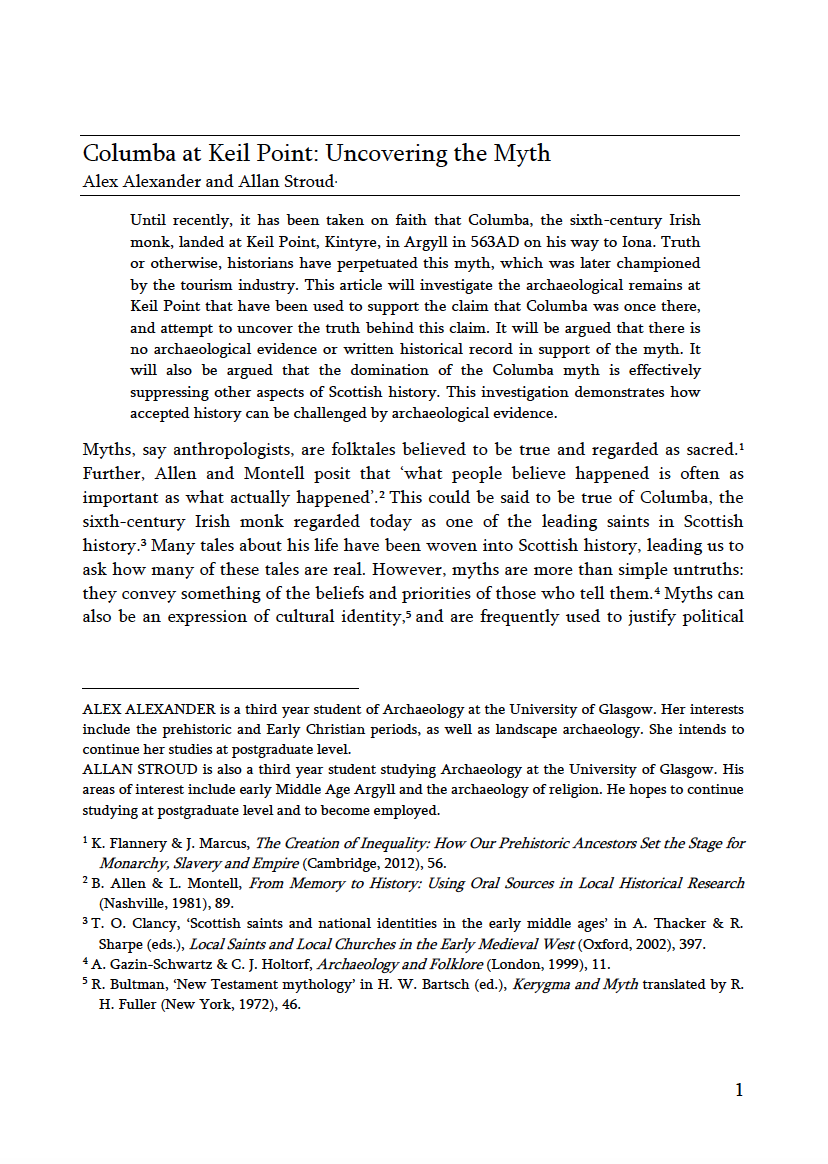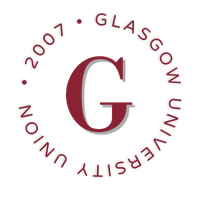Columba at Keil Point
Uncovering the Myth
DOI:
https://doi.org/10.36399/GroundingsUG.8.204Keywords:
St Columba, Keil Point, Iona, Kintyre, Myth, LandingAbstract
Until recently, it has been taken on faith that Columba, the sixth-century Irish monk, landed at Keil Point, Kintyre, in Argyll in 563AD on his way to Iona. Truth or otherwise, historians have perpetuated this myth, which was later championed by the tourism industry. This article will investigate the archaeological remains at Keil Point that have been used to support the claim that Columba was once there, and attempt to uncover the truth behind this claim. It will be argued that there is no archaeological evidence or written historical record in support of the myth. It will also be argued that the domination of the Columba myth is effectively suppressing other aspects of Scottish history. This investigation demonstrates how accepted history can be challenged by archaeological evidence.
References
B. Allen & L. Montell, From Memory to History: Using Oral Sources in Local Historical Research (Nashville, 1981).
Bede, Historia ecclesiastica gentis Anglorum translated by L. Sherley-Price (London, 1990). Originally published in 731.
D. Broun, Scottish Independence and the Idea of Britain from the Picts to Alexander III (Edinburgh, 2007).
R. Bultman, ‘New Testament mythology’ in H. W. Bartsch (ed.), Kerygma and Myth translated by R. H. Fuller (New York, 1972), 1-44. Originally published in 1961.
R. Butter, Cill-names and Saints in Argyll: a Way Towards Understanding the Early Church in Dal Riata? (PhD Thesis, University of Glasgow, 2007).
H. Cheape, ‘Food and liquid containers in the Hebrides: a window on the Iron Age’ in A. Fenton (ed.), Food and Drink and Travelling Accessories: Essays in Honour of Gösta Berg (Edinburgh, 1988), 111-121.
T. O. Clancy, ‘Scottish saints and national identities in the early middle ages’ in A. Thacker & R. Sharpe (eds.), Local Saints and Local Churches in the Early Medieval West (Oxford, 2002), 397-420.
E. Deutsch, ‘Truth and mythology’ in S. Biderman & B-A. Scharfstein (eds.), Myths and Fictions (Leiden, 1993), 41-50.
I. Fisher, ‘The early Christian period’ in D. Omand (ed.), The Argyll Book (Edinburgh, 2004), 71-84.
E. Fitzpatrick, Royal Inauguration of Gaelic Ireland 1100-1600: a Cultural Landscape Study (Woodbridge, 2004).
K. Flannery & J. Marcus, The Creation of Inequality: How Our Prehistoric Ancestors Set the Stage for Monarchy, Slavery and Empire (Cambridge, 2012).
J. E. Fraser, From Caledonia to Pictland: Scotland to 795 (Edinburgh, 2012).
A. Gazin-Schwartz & C. J. Holtorf, Archaeology and Folklore (London, 1999).
A.Grant, ‘The Middle Ages: the defence of independence’ in R. Mitchison (ed.), Why Scottish History Matters (Edinburgh,1991), 29-39.
R. Graves, ‘Introduction’ in F. Guirand (ed.), New Larousse Encyclopaedia of Mythology, new Edition (London, 1989), v-xiii.
W. M. Hennessy, The Annals of Ulster: a Chronicle of Irish Affairs from A.D. 451 to A.D. 1540 (Dublin, 1871).
G. A. F. Knight, Archaeological Light on the Early Christianizing of Scotland (London, 1933).
B. Lacey, Colum Cille and the Columban Tradition (Dublin, 1997).
A. Lane, ‘Citadel of the first Scots’ (2001) 62 British Archaeology. Available <http://www.archaeology.uk.org/ba/ba62/feat1.shtml> [Accessed 05.02.2015].
R. Layton, ‘Folklore and world view’ in A. Gazin-Schwartz & C. J. Holtorf (eds.), Archaeology and Folklore (London, 1999), 26-34.
A. MacDonald, ‘Gaelic Cill(Kil(l)-) in Scottish Place Names’ (1979) 2 Bulletin of the Ulster Place Name Society, 9-19.
C. MacDonald, The History of Argyll (Glasgow, 1950).
A. MacVicar, ‘Irish Heritage’ (1987) 21 The Kintyre Antiquarian and Natural History Society Magazine online. Available: <http://www.ralstongenealogy.com/number21kintmag.htm> [Accessed 04.02.2015].
R. Morris & F. Morris, Scottish Healing Wells: Healing, Holy, Wishing and Fairy Wells of the Mainland of Scotland (Sandy, 1982).
M. R. Nieke & H. B. Duncan, ‘Dalriada: the establishment and maintenance of an early historic kingdom in northern Britain’ in S. Driscoll & M. R. Nieke (eds.), Power and Politics in Early Medieval Britain and Ireland (Edinburgh, 1988), 6-21.
Royal Commission on the Ancient and Historical Monuments of Scotland (RCAHMS), Argyll: An Inventory of the Ancient Monuments, Vol.1 (Edinburgh, 1971).
‘Campbeltown To Tarbert, Loch Fyne: St Columba Journey’ in Scotlandspilgrimjourneys. Available:<http://www.scotlandspilgrimjourneys.com/pilgrim-journeys/5/st-columba-journey/?stageid=6> [Accessed: 10.02.15].
R. Sharpe, ‘Introduction’ in Adomnan, Life of St Columba (London, 1995), 1-99.
A. P. Smyth, Warlords and Holy Men: Scotland AD 80 –1000 (Edinburgh, 1984).
P. Thompson, The Voice of the Past: Oral History, 2nd Edition (Oxford, 1988).
C. Tolan-Smith, The Caves of Mid Argyll: An Archaeology of Human Use (Edinburgh, 2001).
T. Turpie, Scottish Saints, Cults and Pilgrimage from the Black Death to the Reformation, c.1349-1560 (PhD Thesis, University of Edinburgh, 2011).
‘Keil Caves, St Columba's Steps and Dunaverty’ in Walkhighlands. Available: <http://www.scotlandspilgrimjourneys.com/pilgrim-journeys/5/st-columba-journey/?stageid=6> [Accessed: 10.02.15].
Capt. T. P. White, ‘The ecclesiastical antiquities of the district of Kintyre in Argyllshire’ (1871) 9 Proceedings of the Society of Antiquaries of Scotland, 227-30.
Capt. T. P. White, Archaeological Sketches in Scotland: District of Kintyre (Edinburgh, 1873).

Published
Issue
Section
License
Copyright (c) 2015 Alex Alexander, Allan Stroud

This work is licensed under a Creative Commons Attribution 4.0 International License.
The CC BY 4.0 license is a Creative Commons license. This is a non-copyleft free license that is good for art and entertainment works, and educational works. It is compatible with all versions of the GNU GPL; however, like all CC licenses, it should not be used on software. People are free to: Share — copy and redistribute the material in any medium or format; Adapt — remix, transform, and build upon the material for any purpose, even commercially. The licensor cannot revoke these freedoms as long as you follow the license terms. But they must conform to the following terms: Attribution — You must give appropriate credit, provide a link to the license, and indicate if changes were made. You may do so in any reasonable manner, but not in any way that suggests the licensor endorses you or your use. No additional restrictions — You may not apply legal terms or technological measures that legally restrict others from doing anything the license permits.
Please check individual article PDF copies to see if any additional restrictions apply.







